Building your wealth
Wealth Management encompasses crafting tailored strategies for wealth accumulation and retirement security, defining investment goals, executing effective strategies, and accessing diverse investment opportunities under professional guidance.

Our approach to Wealth Management
Wealth Management Process

Wealth management process
Your Morgans adviser will take you through the wealth management planning process, implement your strategies and help you make the most of all opportunities. This wealth management process helps you set short and long-term goals and uses a range of investment strategies to achieve those goals.

The strategies
Strategies are developed around the principles of saving tax, choosing the right investment structures, minimising risk, personal insurance and generating a large-enough asset base to provide you with financial security.

Tax planning
The strategies to save tax involve structuring salary, superannuation, investments and debt. Risk is minimised through the diversification of investments and monitoring portfolio performance.


Are you ready for EOFY?
It’s that time of year again — time to start preparing for the end of the financial year. Don’t leave it to the last minute to get your financial house in order before 30 June. From maximising your superannuation contributions to reviewing your investment portfolio, now is the ideal time to take action.
Download our helpful guides to get started:
Investment Strategies for EOFY
Superannuation Strategies for EOFY
News & insights
Introduction
Michael Knox, Morgans Chief Economist, shares his latest quarterly outlook on global growth, inflation, commodities, and interest rates. Here are the key takeaways for November 2025.
Global Growth Outlook
Growth is slowing but stabilising across major economies:
- US: Eases to 1.8% in 2025 (including effects of US shutdown), recovering to 2.2% in 2026.
- Euro Area: Improves to 1.2% in 2025.
- China: Slows to 4.8%.
- India: Strong at 6.6%.
- Australia: Firms to 1.9%, inflation at 3.5%.
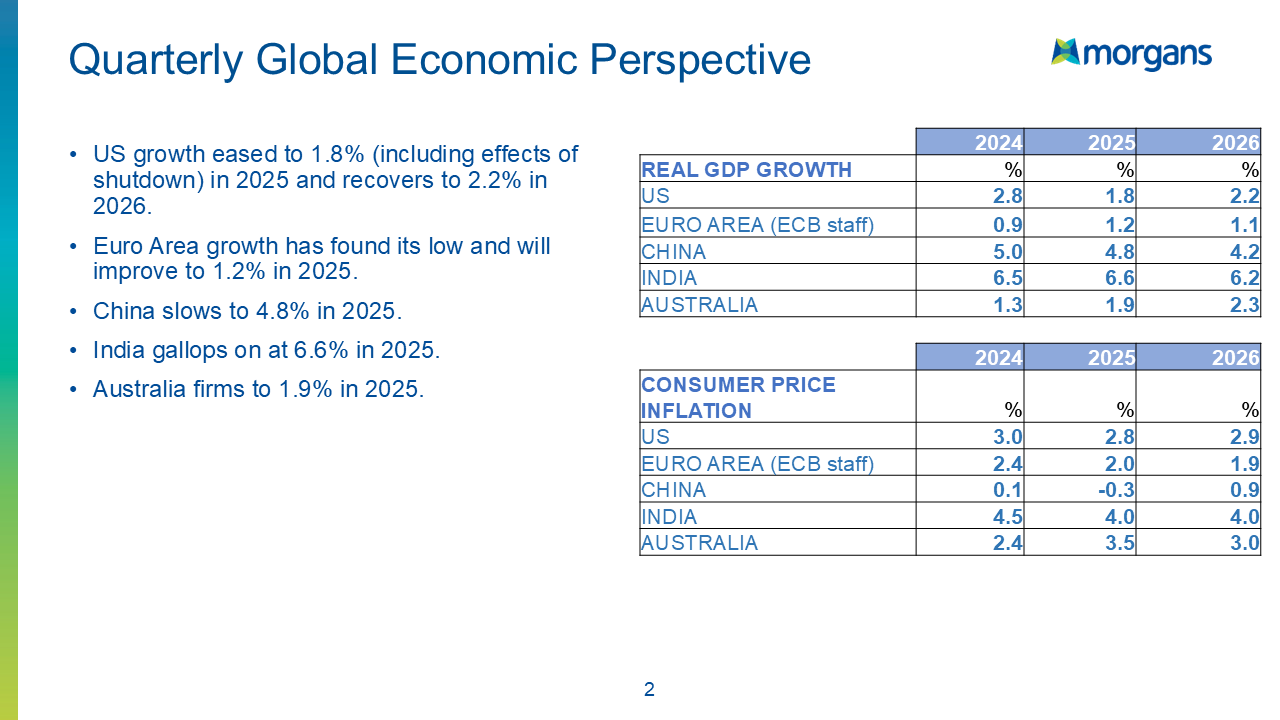
Australia: Inflation & Employment
- Retail electricity prices are rising as subsidies end, adding pressure to inflation.
- Employment growth is soft at 1.5%, below the median of 2.17%.
- Unemployment near 4% suggests inflation around 3.4%, above the RBA target.

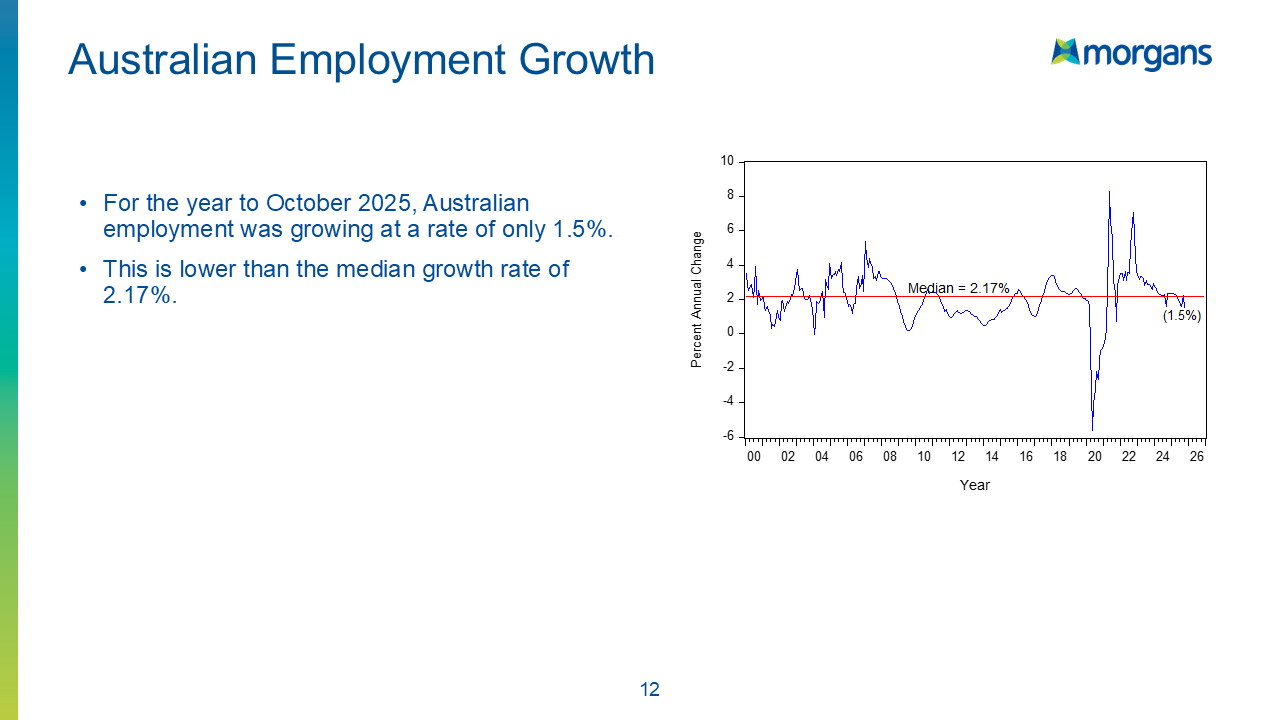
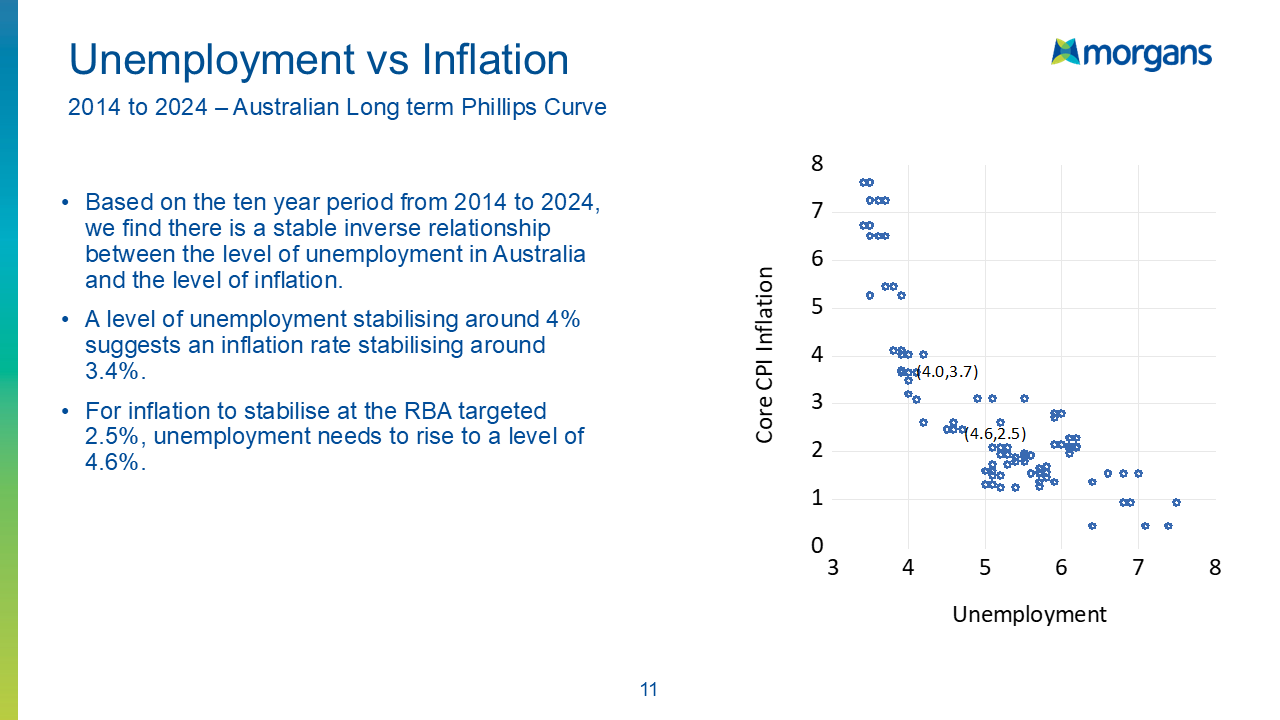
Interest Rates & Monetary Policy
- RBA cash rate expected to rise to 4.1%, driven by higher core inflation.
- In the US, below-trend growth signals potential Fed Funds rate cuts ahead.
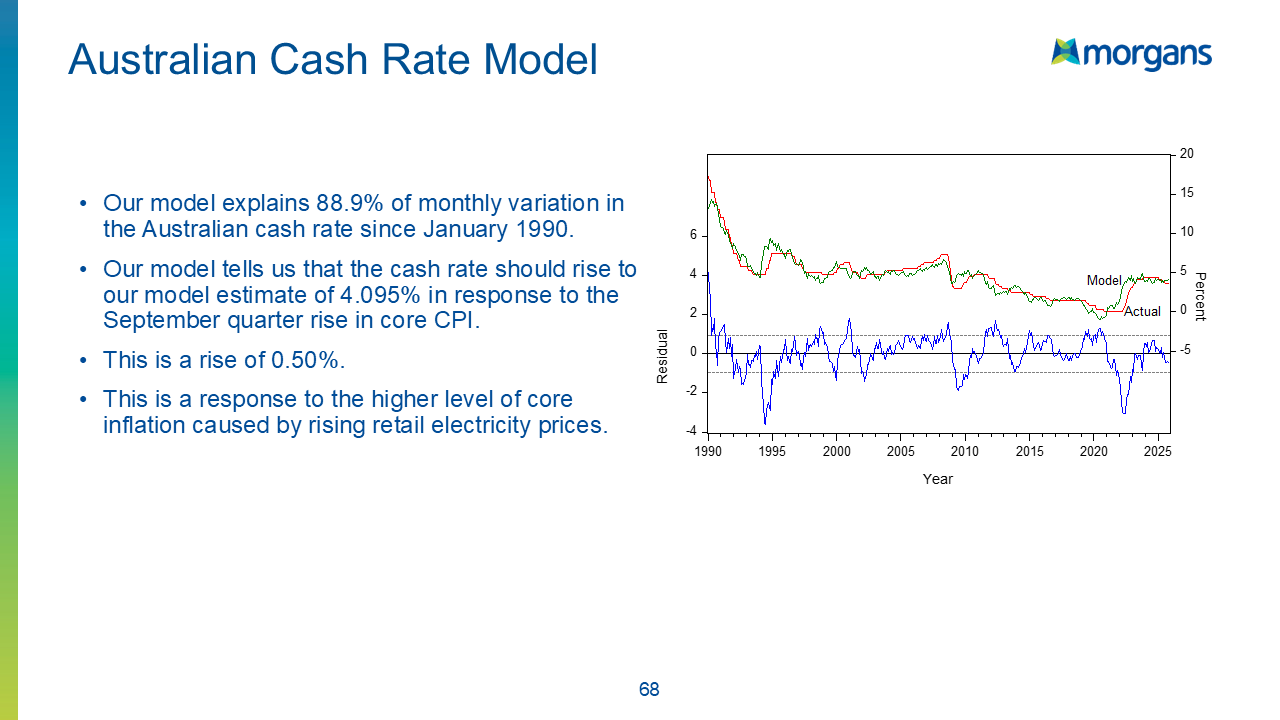
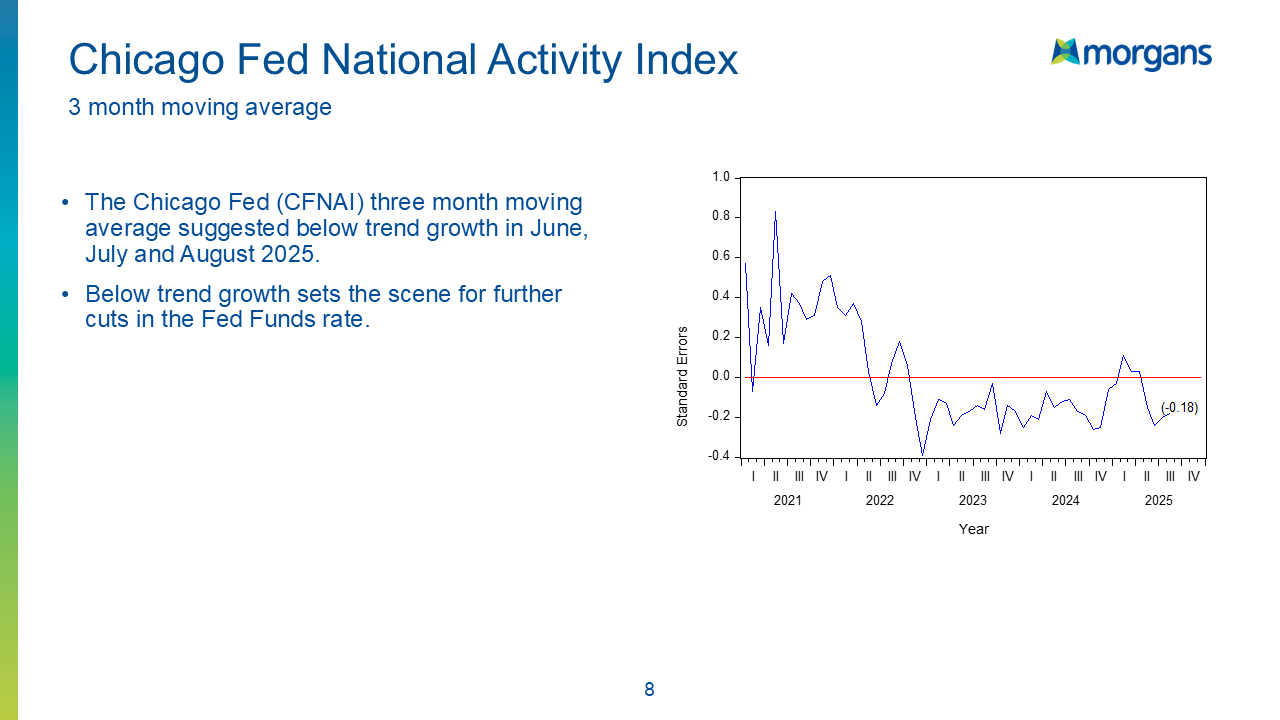
Commodities Snapshot
- Iron Ore: Slightly above fair value at US$100.80.
- Copper: Significantly overvalued at US$10,225 per tonne.
- Nickel & Zinc: Moderately undervalued.
- Gold: At record highs (US$4,013 per ounce) with limited upside.
- Soft Commodities: Wheat and cotton remain undervalued, presenting potential buying opportunities.
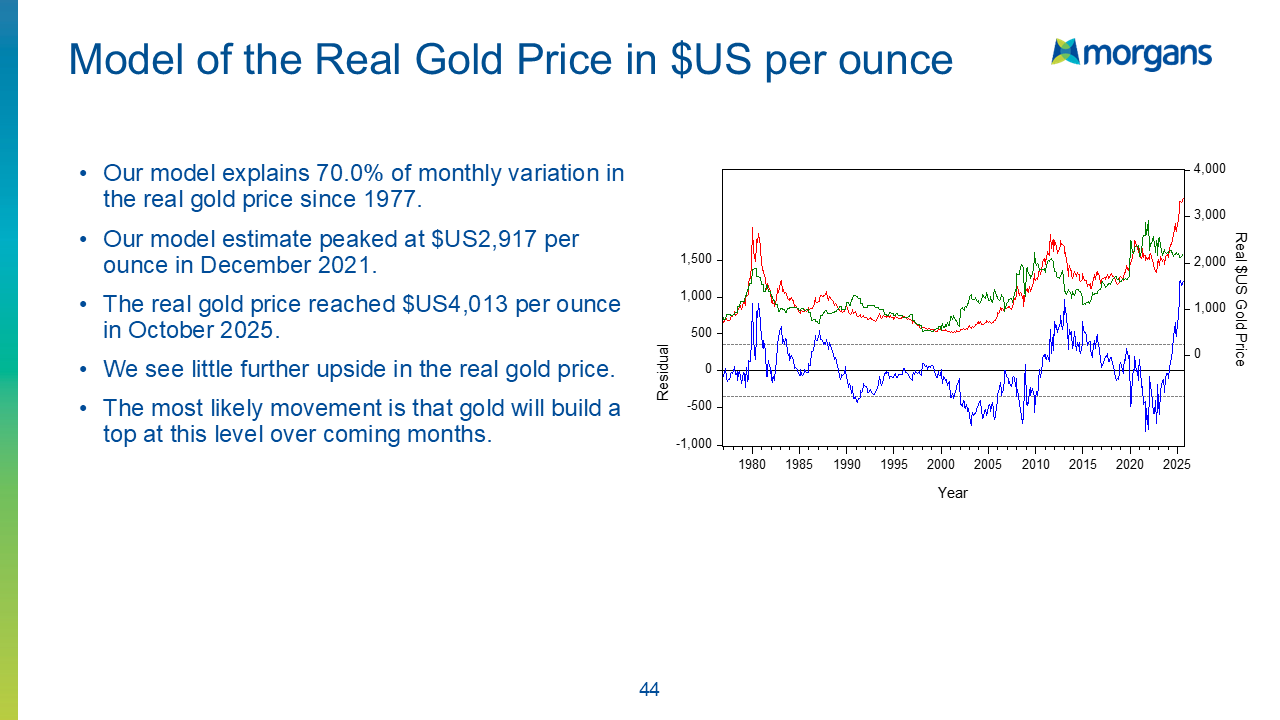
Equities Outlook
- S&P500: Model suggests fair value above current levels, but earnings expected to ease in Q4.
- ASX200: Trading well above model estimates, indicating strong sentiment.
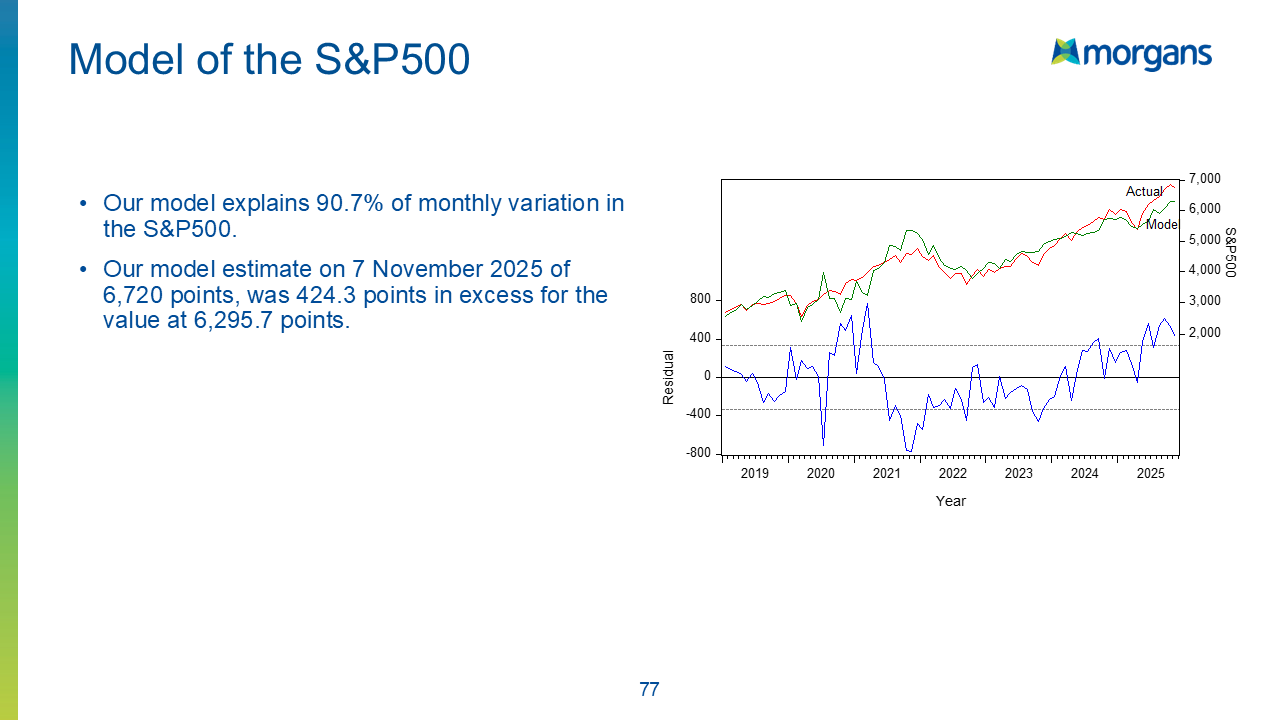
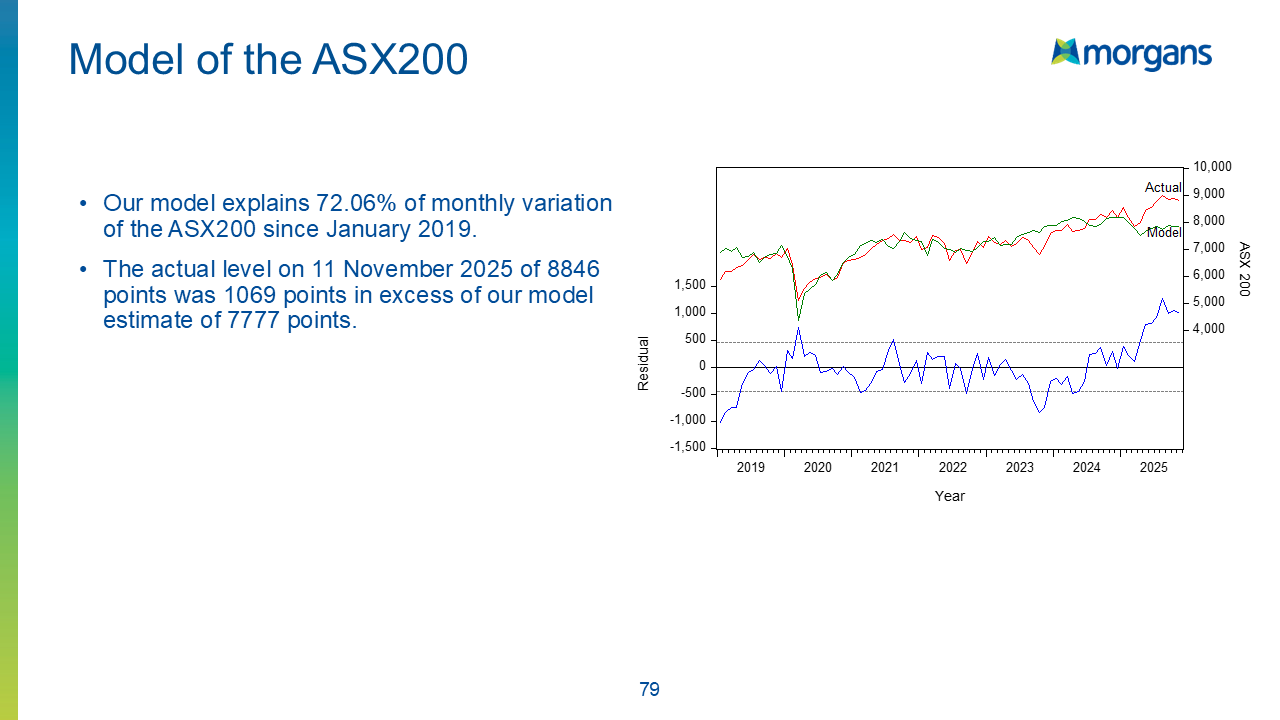
Currency & Bonds
- AUD/USD: Model estimate at US70.94 cents, above current level of US65.48 cents.
- US and German bonds appear moderately overvalued, reflecting strong foreign buying.
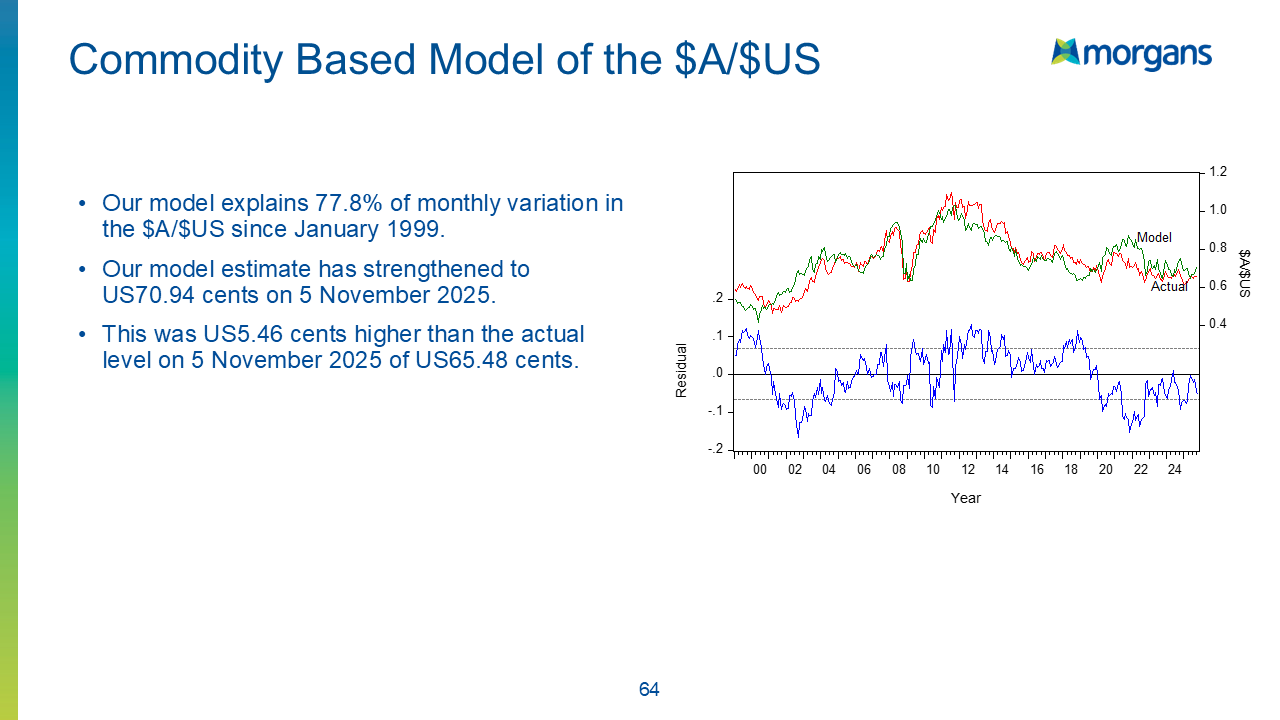
Closing Thoughts
Global growth is slowing, but commodity markets and equities show mixed signals. Inflation pressures in Australia suggest further rate hikes, while US policy may ease. Investors should watch undervalued opportunities in soft commodities and monitor interest rate trends closely.
FAQs
1. What is the outlook for global economic growth in 2025?
Global growth is slowing but stabilising. The US is expected to grow at 1.8%, the Euro Area at 1.2%, China at 4.8%, India at 6.6%, and Australia at 1.9%.
2. Why is Australian inflation expected to remain high?
Inflation pressures are driven by rising retail electricity prices as subsidies end, combined with relatively strong demand and employment trends.
3. Will the Reserve Bank of Australia raise interest rates?
Yes, the RBA cash rate is forecast to rise to around 4.1% in response to higher core inflation.
4. Which commodities are currently undervalued?
Soft commodities like wheat and cotton are significantly undervalued, while iron ore is near fair value and copper remains overvalued.
5. How are equity markets positioned heading into 2026?
The S&P500 is trading below model estimates, suggesting potential upside, while the ASX200 is above fair value, reflecting strong investor sentiment.
DISCLAIMER: Information is of a general nature only. Before making any financial decisions, you should consult with an experienced professional to obtain advice specific to your circumstances.
Why The US Has Higher Productivity
Good morning. Today I want to talk about the U.S. economy in comparison, to other economies and, why it's performing, the way it is. The documents I will refer to are first the IMF, outlook, which is, come out in the last two weeks. That gives us some international comparisons.
For the US economy I use, the monthly outlook from Standard and Poor's, which is, the number one rated by the Congressional Budget Office, well ahead of other economic forecasters. For the US economy, both the IMF and, Standard Poor's agree that growth this year should be 2%. Our own model of the US economy, based on the Chicago Fed National Activity Indicator, is also forcasting US growth of 2%.
Still, that's 2% is less whatever the negative effect is from, from the US shutdown. When the shutdown continues for a month, that growth rate falls from 2% down to about 1.8 % 1.7%. So it's a moderate slowdown. Still growth in the U.S. economy accelerates next year to about 2.2%. I'll talk later on where that growth is coming from.
When we look at growth in other areas we see that: Euro area is miserable. Great Britain is growing faster than the Euro area now. This year the UK should grow by 1.3% but, the Euro area should grow by about 1.2% this year. Euro area growth drifts off to an even more miserable 1.1% next year. But fortunately, that generates a lot of savings to invest in other countries like us. Those savings then go in to the US equities and bond markets and, the Australian stock market and places like that.
China is slowing down to 4.8% this year and 4.2% next year according to the, IMF. Still, heroically India, marches on to 6.6% growth this year and 6.2% next year. For emerging markets, which include the Indo Pacific generally ,Growth is proceeding at about 5.2% this year and 4.7%, next year.
The U.S is still, pretty good in comparison. This year, it's, growing at 2% or, depending on the results of the shutdown. Next US Growth accelerates, to 2.2%, and growth is then about the same the year after.
There's been a lot of debate this year about the effect of tariffs on the US inflation. In spite of higher tariffs , US inflation is stubbornly , stubbornly low. Headline inflation, which includes food and energy this year should be only 2.8%. Hardly something to scare markets. And that continues a 2.9% next year and 2.5% the year after. Amazingly,US core inflation is a bit higher than that 3% this year and 3.3% next year. It's just that food and energy prices are falling in the US. Why can't that happen here?
Lets look at one of the reasons that you get really quite steady growth and relatively low inflation in the US The comparison I want to make here is between US output per hour and Australian output per hour. In the beginning of this year, we had a shocking slowdown in productivity growth because our government decided that was better to hire more, people from the public service than generate employment in the private sector. It is well known that, productivity in the market economy grows much faster than in the, than in the public sector. So, for the first quarter, productivity in Australia grew, or output per hour worked per annum ,grew by 0.3% . The RBA has told us that, they expect output per hour that will rise to about 0.7%per annum , the same as the UK. And we'll be able to maintain productivity growth rate of 0.7%, going forward.
Let's compare that to what's happening in the US economy. This year It looks like the US will be producing labour productivity much higher than the Australia. US Output per hour should grow by 1.6% this year . Next year US Output per hour may grow even more by, 2.1%. Following that US labour productivity the year should grow between 1.6 and 1.7%,. This is full 1% faster than, the Australian economy is expected to grow in terms of productivity. Remember, it's growth and productivity which generates increase in living standards.
There's two reasons, that we can provide for why the U.S., productivity is growing so much faster than ours. One is a flexible labour market. It's an extremely flexible labour market in the US. The current Australian government has made our labour market less flexible, less than it previously was. A second reason is deregulation . The program of deregulation by the US administration is making it easier for business , to do business.
That, of course, in turn generates higher levels of business investment. That higher level of business investments creates more growth. So, it's a series of policies which are different in each country . The result will be that, living standards in, in the U.S are going to start going to be growing significantly faster than they are in Australia.
And that's the end of the good news for the day.
Last time I spoke to you about Australian inflation and its effect on what the RBA might do in its November meeting, I said that expectations for inflation for the year to September, which would be published in October, were between 2.5% and 2.7%. I also said that if inflation came in at the lower estimate of 2.5%, then we could see a rate cut in November.
Well, the numbers are out, and unfortunately, not only are we not getting a rate cut in November, it’s unlikely we’ll see another rate cut any time soon. In fact, it’s fair to say we may be at the very end of the rate-cutting cycle in Australia. The reason is that the core measure, the trimmed mean, which is the RBA’s preferred measure of underlying inflation, came in not at 2.5%, not at 2.6%, and not even at 2.7%, but at a shockingly high 3%.
This result was driven by a 1.3% increase in prices in the previous quarter, which annualises to about 5%, a surprise that wasn’t anticipated. Looking deeper into the quarterly CPI, we saw housing prices rising at 4.7%, health costs up 4.2%, and education costs increasing by 5.3%.
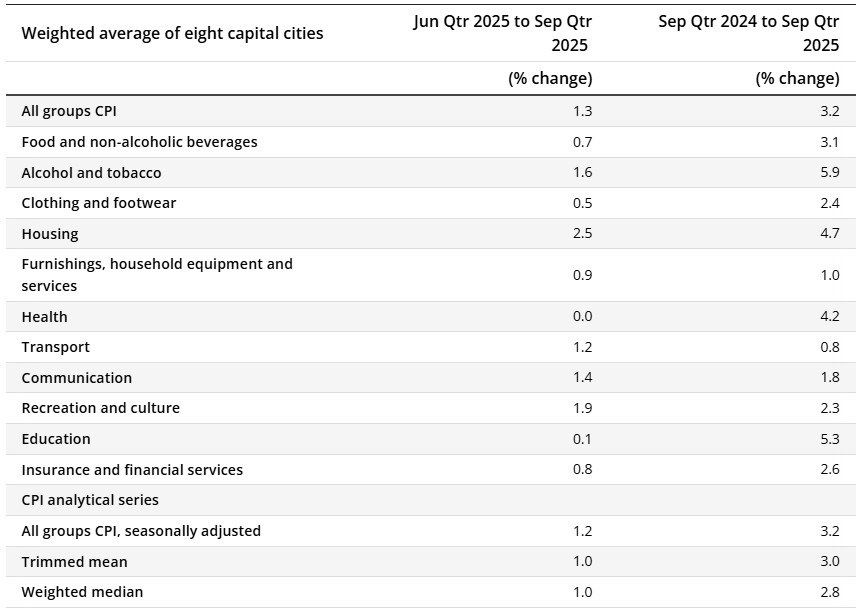
The ABS has indicated that the major source of inflation was a jump in goods inflation, which rose 3%, up 1.1% from the previous quarter, or 4.4% annualised. The standout contributor was electricity, which saw a massive year-on-year increase of 23.6%. Other household fuels actually fell by 1.6%, and annual services inflation was 3.5%.
The ABS attributed this unexpected rise in inflation primarily to electricity prices. But it’s not just electricity prices themselves, it’s the end of Federal Government funding to the states that had been keeping those prices low.
The ABS reported that electricity prices rose 23.6% over the past 12 months, largely because State Government rebates, funded by the Commonwealth under the Energy Bill Relief Fund, have now been used up. These rebates included Queensland’s $1,000 rebate, Western Australia’s $400 rebate, and Tasmania’s $250 rebate. With these rebates exhausted, electricity prices have surged.
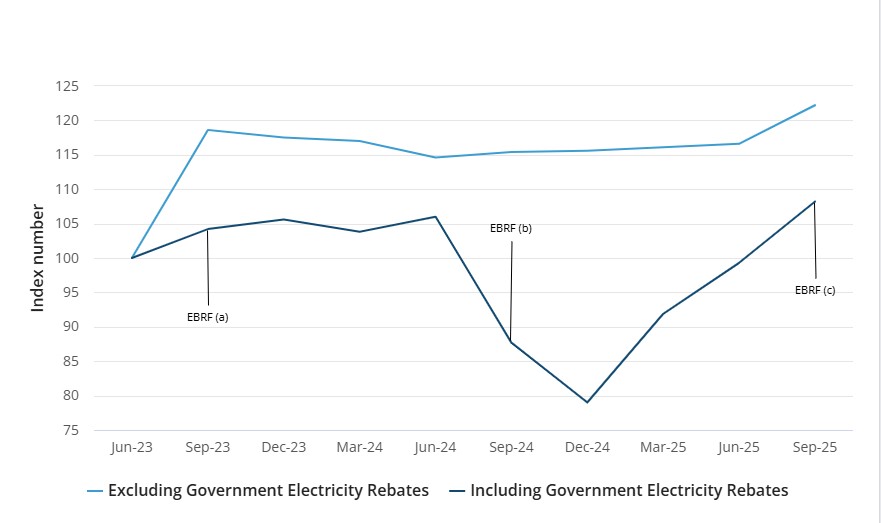
The A
BS data shows electricity prices excluding government rebates, and highlights the impact of the federal funding. Electricity prices really took off in 2023, rising by almost 20%, which posed a political risk for the Federal Government. In response, the Government provided funding to State Governments to suppress those prices. There were schemes in both 2023 and 2024, and ahead of the last election, the subsidised price paid by consumers dropped to around 80% of the original cost, well below the actual cost of generation.
However, since December 2024, those subsidies have been reduced. Over the past year, prices have climbed again, though they remain below the unsubsidised cost, which is now around 122% of the original price, or about a quarter higher than where things stood in 2023.
The result of all this is 3% core inflation. If inflation had come in at 2.5%, rates could have fallen from 3.6% to 3.35%. But with 3% core inflation, rates should need to rise by 25 basis points. That said, we’re likely at the end of the rate-cut cycle.
Is the RBA likely to raise rates? They might consider it, but this is cost-push inflation, not demand-driven inflation, so increasing rates wouldn’t help. It would only worsen the situation. This very high inflation figure, driven by the end of federal electricity subsidies, signals the end of the current series of Australian rate cuts.
Wealth Management FAQs


Morgans delivers wealth management solutions, encompassing financial structuring, tax planning, risk mitigation, and ongoing portfolio oversight. Our advisers adopt a client-focused method, gaining insight into your aspirations to develop customised plans for various life phases. Contact us to find out more.


Morgans retirement planning helps to deliver individualised approaches for asset growth and oversight. We guide you in organising retirement income from superannuation, other investments, and government benefits. We asses investment choices, risk reduction, and financial optimisation.


Morgans offers guidance on superannuation within retirement frameworks. We assist in arranging contributions, asset allocations, and distributions to help oversee your strategy. Find an adviser near you.


Our finance advisers deliver tax planning as part of bespoke financial strategies. Reach out to an adviser for customised recommendations.


Amid the 2025 aged care reforms, Morgans supplies current insights and counsel on monetary effects. Our wealth services optimise funding sources, asset management, and revenue flows to address aged care requirements effectively.


Morgans' advisers invest time in comprehending your distinct ambitions, risk appetite, and current life phase. Leveraging our robust research, we formulate bespoke wealth strategies to offer guidance suited precisely to you, cultivating relationships that span generations.


Through our wealth management, we conduct continuous portfolio surveillance to align with your aims. Advisers monitor returns and refine approaches, ensuring proactive oversight for your reassurance.


We emphasise risk management across all wealth plans, evaluating your comfort level and diversifying holdings.


The Morgans Financial Services Guide is accessible here.









